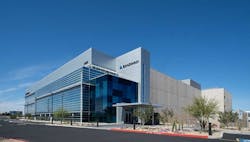Executive Insights: Michael DeVito of Iron Mountain Data Center 2Q 2021
The Data Center Frontier Executive Roundtable features insights from industry executives with lengthy experience in the data center industry. Here’s a look at the insights from Michael DeVito of Iron Mountain.
MICHAEL DeVITO, Iron Mountain
Michael joined Iron Mountain Data Centers in October 2019 as the SVP, Global Sales & Marketing. Prior to joining Iron Mountain Data Centers, Mike was with Digital Realty, where he served as SVP of Sales and led teams in delivering significant new sales growth, including 17 straight quarters of sequential growth. Mike joined Digital Realty via the acquisition of Telx in 2015. Prior to joining Telx, Mike served as EVP of Global Solutions at NTT. Previously, he held various sales, marketing and operations leadership positions at BT Global Services, Equant and MCI. Mike lived in Amsterdam during his time at MCI and spent significant time in Asia while at NTT. He earned a Bachelor of Science from Virginia Tech. Outside of work, Mike enjoys spending time with his wife and two sons, studying history and practicing languages.
Here’s the full text of Michael DeVito’s insights from our Executive Roundtable:
Data Center Frontier: What is the current state of data center rack density, and what lies ahead for cooling as more users put artificial intelligence to work in their applications?
Michael DeVito: There is no single answer anymore to the density question. For retail customers we see that the average density levels haven’t changed a lot over the last couple of years. Three kilowatts to 5 kilowatts per rack is most common.
The large cloud providers are more driven to optimize processing power per rack. This is obviously reflected in the average density. Today 8 kilowatts to 12 kilowatts is what we are seeing, but cloud providers continue to push the density limits. Expectations are that the density of hyperscale deployments will continue to increase.
The growing use of A.I. applications means higher requirements for processing power and thus for higher densities. The so-called supercomputers which today are used to process real complex algorithms already require densities which can go up to 25 kilowatts per rack and even higher.
We see liquid cooling solutions as a potential solution to deal with these types of densities in the future but we also feel that part of the solution in this area should come from the IT-hardware designers. By optimizing the power and processor cycles and directly cooling processors on the board, further optimization should be possible.
Data Center Frontier: Many industries are experiencing difficulty finding enough skilled workers. What’s the outlook for data center staffing, and what are the key strategies for finding talented staff?
Michael DeVito: Talent recruitment and retention are absolutely two of our highest priorities as we build and grow our global team. While job functions across data center providers are fairly similar, there are numerous other factors that come into play when competing for talent.
Where Iron Mountain stands out, and the cornerstone of our culture, is our commitment to innovation, inclusion, integrity and long-term sustainable success. We have aggressive goals to meet from a diversity, equity inclusion standpoint as well as from our environmental sustainability programs. We continue to invest in local programs, such as Women in IT and STEAM programs, across the globe in order to have a positive impact on influencing IT & Technology as desirable career choices.
From a retention standpoint, we continually assess the talent across our whole team to determine if we can grow talent internally rather than bringing in external resources. We are heavily invested in succession planning, training and development for our team including rotational assignments and working in different regions if there is interest.
The Iron Mountain AZP-2 data center in Phoenix, Arizona. (Photo: Iron Mountain)
Data Center Frontier: How have enterprise data center needs evolved during the pandemic? What do you expect for 2021?
Michael DeVito: It goes without saying that the pandemic rapidly sped up enterprise adoption of cloud and other digital technologies. Both B2B and B2C consumers were forced to rely solely on online, digital platforms and channels to communicate, sell and transact business. Data center providers benefitted from the digital adoption and demand surge and we don’t see that changing any time soon. The pandemic certainly tested the data center industry as a whole and we proved that we were able to keep the digital economy connected, powered and thriving.
While we don’t expect to see the reactive surge of growth that we saw last year, we do expect to see strong continual growth as enterprises have witnessed the advantages, benefits and peace of mind that come from partnering with a data center provider.
Data Center Frontier: Edge computing continues to be a hot topic. How is this sector evolving, and what use cases and applications are gaining the most traction with customers?
Michael DeVito: The explosion in IoT is driving huge volumes of transactional activity closer to the edge of the network. This means that locating compute nodes within low latency reach of these devices is both a critical necessity and a big challenge for enterprises and clouds.
To compete in the digital economy, businesses need transactional agility in connecting multiple platforms, suppliers and services from the edge, to the core and to the cloud. This process supports use cases that reside around low latency, data residency, user experience, and applies to a multitude of industries including gaming, high frequency trading, travel, finance and healthcare.
Iron Mountain is seeing increased demand for edge markets, especially for key strategic assets that we have within the broader Iron Mountain real estate portfolio. We believe edge is not only here to stay, but will be a major driver of global growth and connectivity.
